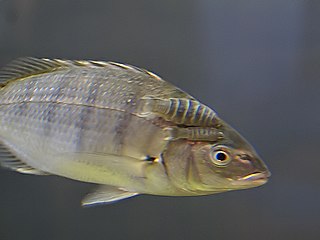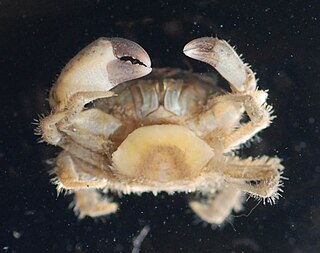Related Research Articles

Isopoda is an order of crustaceans that includes woodlice and their relatives. Isopods live in the sea, in fresh water, or on land. All have rigid, segmented exoskeletons, two pairs of antennae, seven pairs of jointed limbs on the thorax, and five pairs of branching appendages on the abdomen that are used in respiration. Females brood their young in a pouch under their thorax.

Rhizocephala are derived barnacles that parasitise mostly decapod crustaceans, but can also infest Peracarida, mantis shrimps and thoracican barnacles, and are found from the deep ocean to freshwater. Together with the sister group the Thoracica, they make up the infraclass Cirripedia. Their body plan is uniquely reduced in an extreme adaptation to their parasitic lifestyle, and makes their relationship to other barnacles unrecognisable in the adult form. The name Rhizocephala derives from the Greek roots ῥίζα and κεφαλή, describing the adult female, which mostly consists of a network of thread-like extensions penetrating the body of the host.

Cymothoa exigua, or the tongue-eating louse, is a parasitic isopod of the family Cymothoidae. This parasite enters fish through the gills. The female attaches to the tongue and the male attaches on the gill arches beneath and behind the female. Females are 8–29 millimetres (0.3–1.1 in) long and 4–14 mm (0.16–0.55 in) wide. Males are approximately 7.5–15 mm (0.3–0.6 in) long and 3–7 mm (0.12–0.28 in) wide. The parasite severs the blood vessels in the fish's tongue, causing the tongue to fall off. It then attaches itself to the remaining stub of the tongue and becomes the fish's new tongue.
Thompsonia is a genus of barnacles which has evolved into an endoparasite of other crustaceans, including crabs and snapping shrimp. It spreads through the host's body as a network of threads, and produces many egg capsules which emerge through joints in the host's shell.

Austrominius modestus is a species of barnacle in the family Austrobalanidae, native to Australia, Tasmania and New Zealand, but now spread to Britain and the north west coasts of Europe. It reaches a maximum size of about 10 millimetres (0.39 in) in diameter.

Semibalanus balanoides is a common and widespread boreo-arctic species of acorn barnacle. It is common on rocks and other substrates in the intertidal zone of north-western Europe and both coasts of North America.

The Cymothoidae are a family of isopods in the suborder Cymothoida and are found in both marine and freshwater environments. Cymoithoids are ectoparasites, usually of fish, and among their number they include the bizarre "tongue-biter" which attaches to a fish's tongue causing it to atrophy, and replaces the tongue with its own body. Ceratothoa oestroides is one of the most devastating ectoparasites in Mediterranean aquaculture. Around 40 genera and more than 380 species of cymothoid are recognised. Species of the Cymothoidae are generally found in warmer waters and rarely in the cool and cold climates.

Chthamalus stellatus, common name Poli's stellate barnacle, is a species of acorn barnacle common on rocky shores in South West England, Ireland, and Southern Europe. It is named after Giuseppe Saverio Poli.

Parasitic castration is the strategy, by a parasite, of blocking reproduction by its host, completely or in part, to its own benefit. This is one of six major strategies within parasitism.

Idotea balthica is a marine isopod which lives on seaweed and seagrass in the subtidal zone of rocky shores.

Aega psora is a species of isopod crustacean that parasitises a number of fish species in the North Atlantic. It is a serious ectoparasite of larger species of fish, particularly when they are injured.
The Hemioniscidae are a family of marine isopod crustaceans in the suborder Cymothoida. The original description was made by Bonnier in 1900. Members of this family are parasitic on cirripede barnacles.
The Entoniscidae are a family of marine isopod crustaceans in the suborder Cymothoida. Members of this family are parasites of brachyuran and anomuran crabs, living in their hosts' haemocoel. A small chitinised hole develops through the host's exoskeleton through which the isopod can communicate with the environment. The female isopod bears little resemblance to any free-living isopod, but the morphology of the larvae show their taxonomic affiliations.
The Aegidae are a family of isopod crustaceans. The adults are temporary parasites of fish, feeding on their hosts' blood before dropping off to digest the meal. They differ from members of the family Cirolanidae in having only three pairs of hook-like pereiopods, whereas in Cirolanidae all seven pairs of pereiopods are hooked. The family contains the following genera:

Gnathia marleyi is a species of crustacean in the family Gnathiidae. It is named after reggae musician Bob Marley. It is a parasite that infests and feeds on the blood of such fish as the French grunt. This tiny species is only found in the Caribbean Sea. It only eats while in the juvenile stage. It can be found hiding among sea sponges, algae, and pieces of dead coral.
Anilocra pomacentri is a species of marine isopod in the family Cymothoidae. It is found off the coast of eastern Australia and is an external parasite of the yellowback puller, a species of damselfish. The presence of the parasite on a fish causes a significant slowing of the growth rate and an increased mortality.
Parorchis acanthus is a parasitic flatworm of the class Trematoda. It is a parasitic castrator of the common periwinkle Littorina littorea. Unlike many trematode species it encysts on hard surfaces and not inside a second intermediate host.

Loxothylacus panopaei is a species of barnacle in the family Sacculinidae. It is native to the Gulf of Mexico and Caribbean Sea. It is a parasitic castrator of small mud crabs in the family Panopeidae, mostly in the Gulf of Mexico, the Caribbean Sea and the eastern Atlantic Ocean.

Sacculina carcini, the crab hacker barnacle, is a species of parasitic barnacle in the family Sacculinidae, in particular a parasitic castrator, of crabs. The crab that most often is used as a host is the green crab, the natural range of which is the coasts of Western Europe and North Africa. It can be found attached to the crab's abdomen and affect consumption rates by humans.

Clistosaccus is a genus of barnacles which are parasitic on hermit crabs. It is a monotypic genus, and the single species is Clistosaccus paguri, which is found in the northern Atlantic Ocean and the northern Pacific Ocean.
References
- ↑ Christopher Boyko & Marilyn Schotte (2011). M. Schotte; C. B. Boyko; N. L. Bruce; G. C. B. Poore; S. Taiti & G. D. F. Wilson (eds.). "Hemioniscus balani Buchholtz, 1866". World Marine, Freshwater and Terrestrial Isopod Crustaceans database. World Register of Marine Species . Retrieved February 13, 2011.
- 1 2 3 4 Nicola White (2008). "An acorn barnacle - Semibalanus balanoides - General biology". Marine Life Information Network: biology and sensitivity key information sub-programme. Marine Biological Association of the United Kingdom.
- 1 2 S. M. Blower & J. Roughgarden (1988). "Parasitic castration: host species preferences, size-selectivity and spatial heterogeneity" (PDF). Oecologia . 75 (4): 512–515. doi:10.1007/BF00776413. Archived from the original (PDF) on 2016-03-04. Retrieved 2011-02-13.
- 1 2 "Macrobenthos of the North Sea - Crustacea - Hemioniscus balani". Marine Species Identification Portal. Retrieved 14 February 2011.